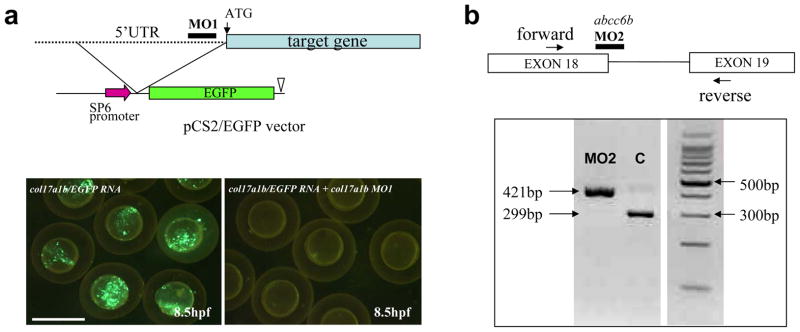Figure 3.
Morpholino-mediated knockdown of zebrafish genes. (a) A morpholino (MO1) corresponding to the col17a1b gene was used to target the 5′ untranslated region of the corresponding mRNA to prevent translation. To determine the efficacy of morpholino in down-regulating the translation, an expression construct consisting of SP6 promoter, 5′ UTR of the col17a1b gene, and downstream enhanced green fluorescent protein (EGFP) reporter gene was generated. Microinjection of mRNA transcribed in vitro from the pCS2/EGFP vector to 1–4 cell stage embryos, shows green fluorescence at 8.5 hpf (lower left panel). Co-injection of this mRNA together with the MO1 morpholino completely abolished the fluorescence, indicating inhibition of the translation (Scale bar = 1 mm). (b) A morpholino (MO2) corresponding to the zebrafish abcc6b gene was placed on the exon 18/intron 18 splice junction. Efficiency of the morpholino in preventing splicing of the abcc6b pre-mRNA into mature mRNA was monitored by RT-PCR using primers placed on exon 18 (forward) and exon 19 (reverse). PCR of the genomic sequence resulted in a 421 bp fragment while fully spliced cDNA yields a 299 bp fragment devoid of intron 18 (122 bp). RT-PCR of morpholino (MO2)-treated zebrafish embryo reveals the presence of the 421 bp mRNA sequence only, indicating complete inhibition of the removal of intron 18 by splicing. Since intron 18 sequence is out-of-frame, this results in complete absence of the abcc6b protein product. (Figures 3a and b are reproduced from Kim et al, 2010, and Li et al, 2010, respectively, with permission).

